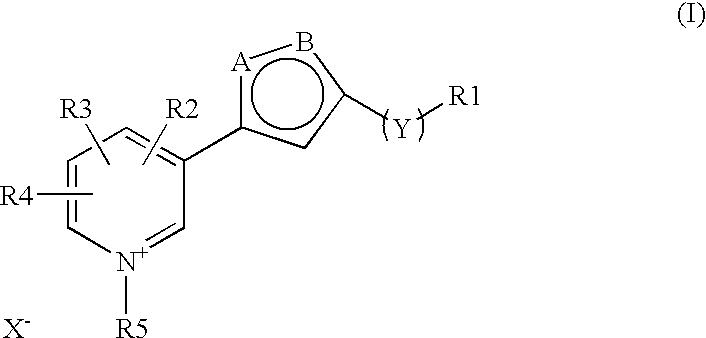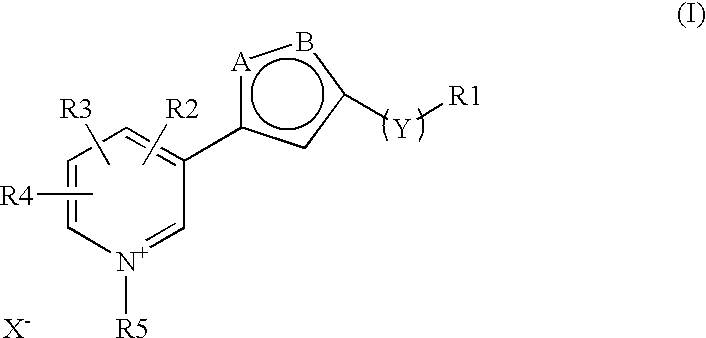Compounds for the management of aging-related and diabetic vascular complications, process for their preparation, therapeutic and cosmetic uses thereof
- Summary
- Abstract
- Description
- Claims
- Application Information
AI Technical Summary
Benefits of technology
Problems solved by technology
Method used
Image
Examples
example 1a
[0312]The in vitro AGE formation, studied in the laboratory, by incubating reducing sugar glucose, with protein bovine serum albumin, resulted in browning of solution and increase in the fluorescence. Fluorescence was used as the criteria to monitor the increased AGE formation.
Materials:
[0313]Bovine serum albumin (fraction V) (BSA)[0314]Glucose, analytical grade[0315]Phosphate buffered saline (PBS)
Equipment:[0316]Microplate ELISA Reader-Spectramax Plus (Molecular Devices, USA)[0317]Microplate washer, (Bio-Tec Instruments, USA)[0318]pH meter[0319]Methods of experiment: Elisa (Enzyme Linked Immunosorbent Assay)
[0320]160 mg / ml of protein, bovine serum albumin, BSA and 1.6M glucose sugar were dissolved in phosphate buffered saline, PBS. Sodium azide was added at 0.02% concentration as a preservative. The solution was filtered asceptically through a 0.22 μM filter and kept for aging at 37° C. for 16 weeks. After 16 weeks the solution was dialyzed against PBS, aliquoted and stored at −20°...
example 1b
Gel Permeation Chromatography Based Method
[0336]Gel Permeation Chromatography based method was used to determine AGE breaking activities of the compounds.
Principle:
[0337]Separation by Gel Permeation Chromatography (GPC) depends on differences in the size, more precisely the hydrodynamic volume, of the proteins in a sample. The larger molecules do not enter the pores of the column particles and elute in void volume of the column (V0). The pores of a column particle are differentially accessible to smaller particles, depending on their size. This volume of the column is called (V1). The total accessible volume (Vt) is the sum of the volume outside the particles (V0) and the volume accessible inside the particles (V1):
Vt=V0+Vi
Therefore, in a typical Gel Permeation Chromatography (GPC) run, high molecular weight molecules elute at a lower retention time whereas lower molecular weight molecules are retained for longer time. For the purpose of quantification, the area under the curve for...
example 1c
Test for AGE Inhibiting Activity.
[0348]The following method was used to determine the inhibitory effect of the test compounds.
[0349]The following method was used to determine the inhibitory effect of the test compounds on Maillard reaction in-vitro. This method is adopted from U.S. Pat. No. 5,514,676 and European Patent No. 0 339 496 A2.
[0350]A solution of Bovine Serum Albumin (BSA), ribose and test compound was prepared in Phosphate Buffer Saline (PBS, pH 7.4) so as to have final concentration of BSA and ribose at 10 mg / ml and 500 mM respectively. Addition of compound was done in aseptic conditions. Sodium azide (0.02%) was also added in this solution in order to prevent microbial growth. A separate tube containing BSA, ribose and sodium azide in the same concentration and buffer as above, but without any test compound, was also incubated as positive control. After incubation at 37° C. for 7 days, 40 micro liter sample from each tube was removed and diluted with PBS to have final c...
PUM
| Property | Measurement | Unit |
|---|---|---|
| Fraction | aaaaa | aaaaa |
| Fraction | aaaaa | aaaaa |
| Fraction | aaaaa | aaaaa |
Abstract
Description
Claims
Application Information
 Login to View More
Login to View More - R&D
- Intellectual Property
- Life Sciences
- Materials
- Tech Scout
- Unparalleled Data Quality
- Higher Quality Content
- 60% Fewer Hallucinations
Browse by: Latest US Patents, China's latest patents, Technical Efficacy Thesaurus, Application Domain, Technology Topic, Popular Technical Reports.
© 2025 PatSnap. All rights reserved.Legal|Privacy policy|Modern Slavery Act Transparency Statement|Sitemap|About US| Contact US: help@patsnap.com



